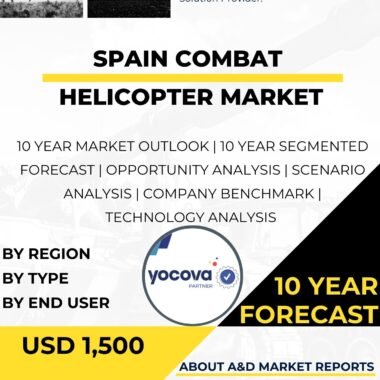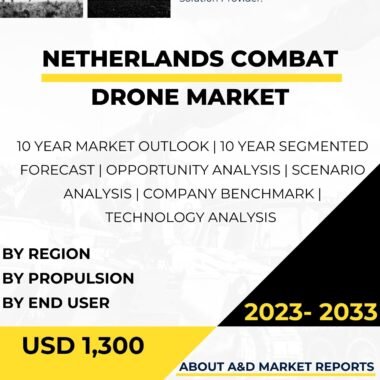Description
The combat helicopter market in France is a crucial and dynamic segment of the country’s defense industry, playing a significant role in enhancing its military capabilities and addressing the evolving security challenges. As a major player in the global arms market, France has been actively involved in the research, development, and production of advanced combat helicopters to meet the growing demand for versatile rotary-wing platforms and support its defense needs. This essay provides an overview of France’s combat helicopter market, focusing on its significance, key players, technology advancements, applications, international collaborations, policy considerations, and future prospects.
The significance of France’s combat helicopter market lies in its role as a critical enabler of modern warfare. Combat helicopters are versatile aerial platforms capable of conducting a wide range of military missions, including combat support, troop transport, reconnaissance, and anti-armor operations. These helicopters provide French forces with enhanced mobility, firepower, and situational awareness, making them an indispensable asset in modern military operations.
Key players in France’s combat helicopter market include government entities, defense companies, and research institutions. The French Ministry of Armed Forces, through its procurement agency, the Direction G?n?rale de l’Armement (DGA), plays a central role in overseeing the acquisition and development of combat helicopters for the country’s armed forces. Additionally, private defense companies like Airbus Helicopters, Safran Helicopter Engines, and Thales have been instrumental in the research, development, and production of advanced combat helicopter systems.
Technological advancements have been pivotal in shaping the growth of France’s combat helicopter market. Innovations in rotorcraft design, avionics, sensor technology, and weapon systems have significantly improved the capabilities of combat helicopters. Advanced sensors and radars provide increased situational awareness, while precision-guided munitions and anti-tank missiles enhance the helicopters’ firepower.
The applications of combat helicopters in France are diverse and critical for various military operations. One of the primary applications is in close air support (CAS) and combat support roles. Combat helicopters can provide direct fire support to ground troops, engage enemy targets, and suppress enemy positions with their onboard weapons systems.
Furthermore, combat helicopters play a crucial role in troop transport and air assault missions. These helicopters can rapidly transport troops to and from the battlefield, insert special forces into hostile environments, and conduct search and rescue operations.
Additionally, combat helicopters are used for reconnaissance and intelligence gathering. Equipped with advanced sensor suites, they can conduct surveillance and gather vital information about enemy movements and activities.
France’s combat helicopter market has also benefited from strategic international collaborations. The country has engaged in partnerships with other nations and defense industries to share technological expertise, collaborate on joint research and development programs, and facilitate the exchange of knowledge and resources. Such collaborations have strengthened France’s defense relationships and expanded the market reach for its combat helicopter technologies.
Policy considerations play a significant role in shaping France’s combat helicopter market. The country adheres to international regulations and arms control treaties concerning the use and export of military helicopters and their associated weapon systems. Additionally, national policies prioritize the development and deployment of advanced combat helicopters to enhance military capabilities and support French defense interests.
Looking ahead, the future prospects of France’s combat helicopter market are promising. As the security landscape continues to evolve, combat helicopters are expected to remain a vital component of the country’s defense strategy. The demand for versatile rotary-wing platforms with increased range, endurance, and survivability is likely to grow.
However, challenges remain for the market. One such challenge is the need for continuous research and development to stay ahead of evolving technologies and address potential threats, such as anti-aircraft systems and electronic warfare. As adversaries develop more sophisticated air defense capabilities, France must invest in cutting-edge research to maintain its position as a leader in the global combat helicopter market.
Moreover, ensuring cost-effectiveness and efficient fleet management are crucial to meet the demands of both domestic and international customers. Streamlining production processes and optimizing logistical support will help maximize the lifecycle value of combat helicopters and ensure their operational readiness.
To address these challenges and seize opportunities, France’s combat helicopter market must focus on continuous innovation and collaboration. Emphasizing the integration of advanced avionics, sensor technology, and weapon systems will enable the production of more efficient and effective combat helicopters.
In conclusion, France’s combat helicopter market is a critical component of its defense industry, providing essential capabilities for modern military operations. Key players, technology advancements, applications, international collaborations, policy considerations, and future prospects all contribute to the market’s significance. The future prospects of the market are promising, driven by the increasing demand for advanced combat helicopters to enhance military effectiveness and maintain France’s position as a technologically advanced military power. By maintaining its focus on innovation, quality, and international cooperation, France can continue to strengthen its position in the global combat helicopter market.




